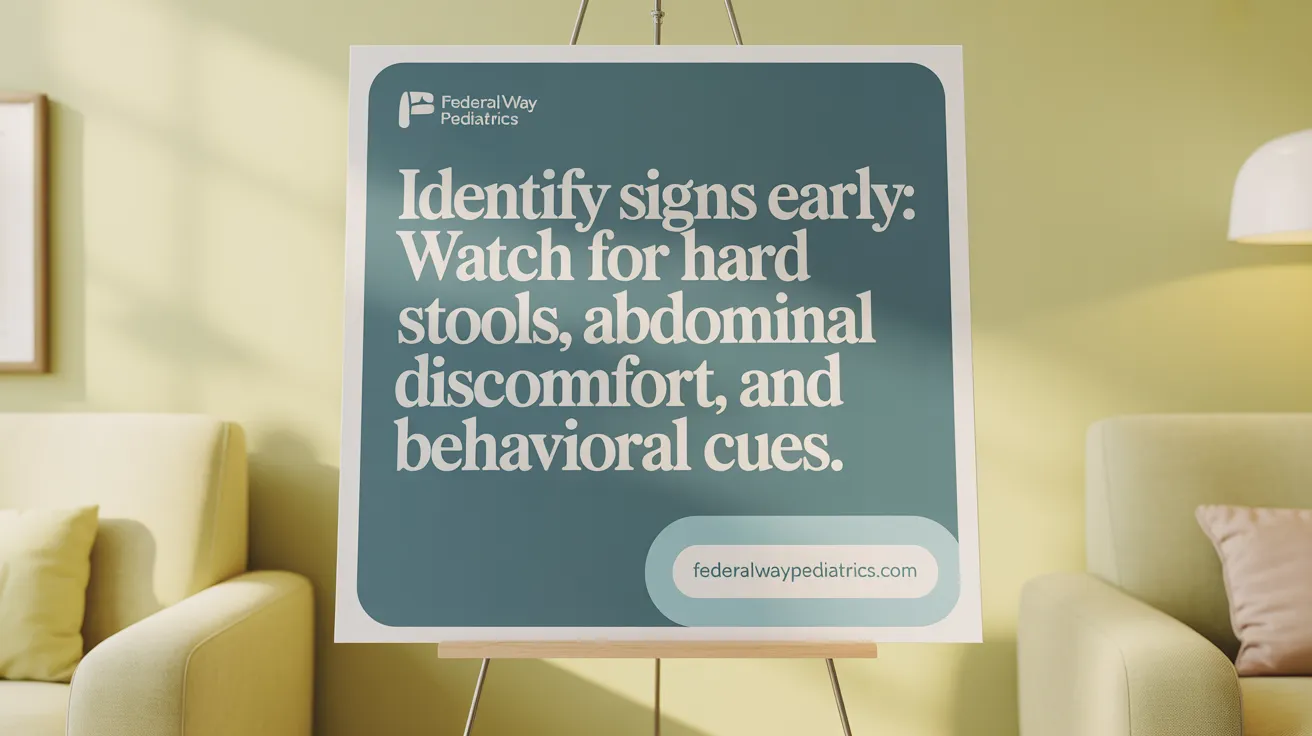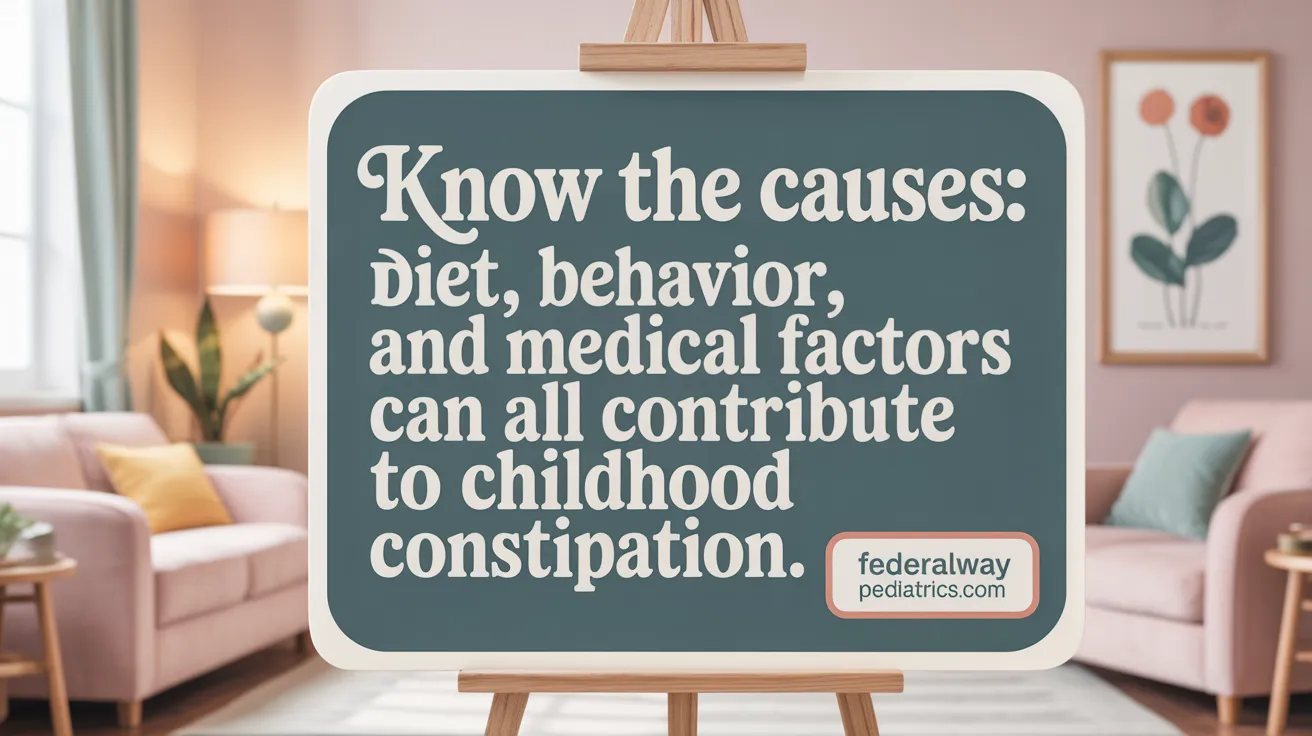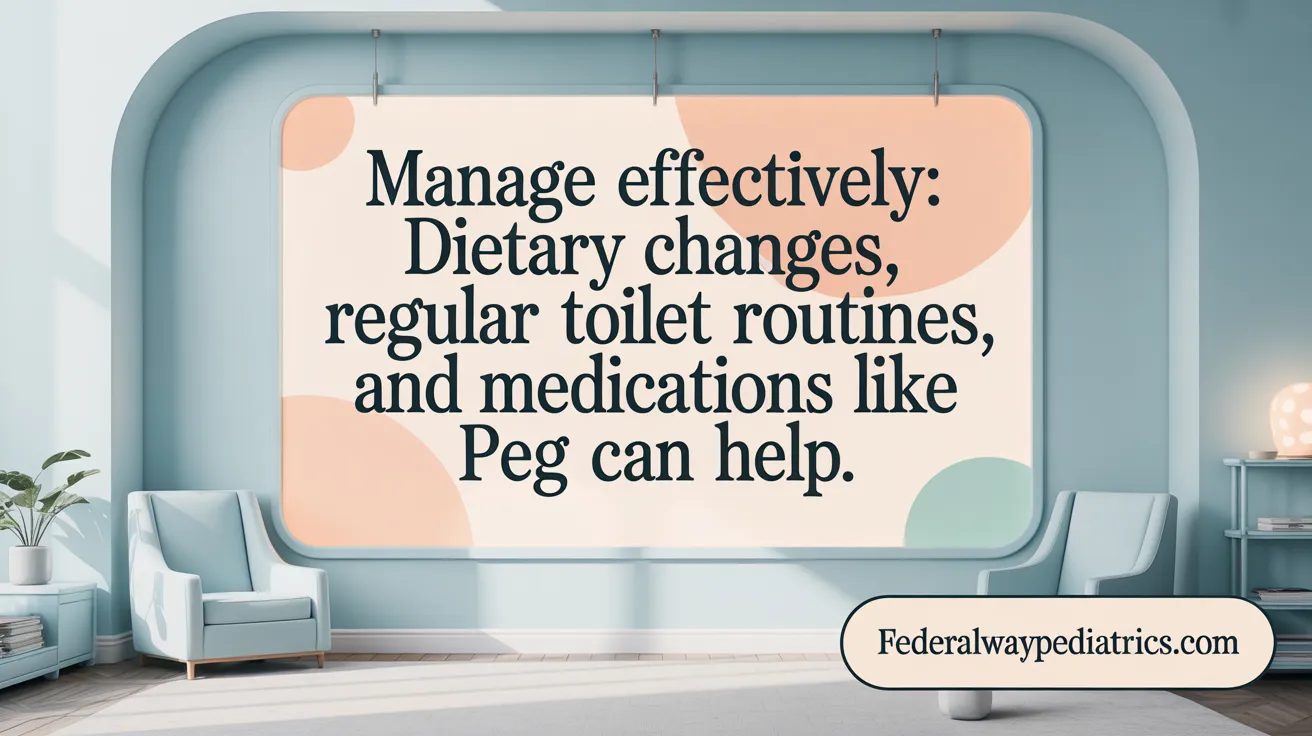Overview of Childhood Constipation
Constipation in young children is a common concern that frequently brings caregivers to pediatricians. It involves infrequent or difficult bowel movements and can cause discomfort and distress for both children and families. Recognizing symptoms early and knowing when to seek medical advice is pivotal in preventing complications and ensuring effective treatment. This article explores the causes, symptoms, risk factors, and guidelines for when to seek help, alongside management strategies to support children's digestive health.
Recognizing Common Symptoms of Constipation in Young Children

What are the common symptoms of constipation in young children?
Constipation in children aged 1 to 4 years often presents with infrequent bowel movements, typically fewer than three times per week. The stool tends to be hard, dry, and large, sometimes resembling pellets, which can make passing it painful or difficult. Children may experience abdominal discomfort such as cramping, bloating, or a swollen belly.
Behavioral signs are common, with children clenching their buttocks, crossing their legs, or twisting their bodies to avoid pain during defecation. They might also pass small amounts of liquid stool or have soiled underwear due to stool leakage, known as encopresis. Additional signs include a decreased appetite, nausea, and vomiting in more severe cases.
Children with constipation may grimace or show signs of discomfort when trying to pass stool, often straining and pushing hard. Some might display behavioral cues such as hiding or being unusually quiet. Visible blood on stools can occur when hard stool causes tiny tears in the anal skin.
While constipation is usually not dangerous, if it persists or worsens, it can lead to complications like anal fissures or rectal bleeding. Recognizing these symptoms early helps prevent the development of more serious issues and ensures timely management.
Understanding Causes and Risk Factors of Childhood Constipation

What causes constipation in children and what are the risk factors?
Constipation in children generally results from slow movement of stool through the large intestine, causing the stool to become hard, dry, and difficult to pass. This situation is often linked to behavioral issues such as stool withholding, especially in children who want to avoid painful or difficult bowel movements.
Diet plays a significant role in constipation. A diet low in fiber and fluids, combined with inadequate physical activity, can contribute to infrequent bowel movements. Certain foods, like excessive dairy or low-fiber snacks, can worsen the condition.
Medical conditions also factor into the causes of constipation. Rare but serious issues like Hirschsprung disease, cystic fibrosis, or neurological abnormalities can impair bowel function. Additionally, side effects from medications or food allergies such as cow's milk protein allergy may lead to constipation.
Psychosocial and behavioral factors influence bowel habits in children. Early or inconsistent toilet training, fear of using unfamiliar or public toilets, and emotional stress at home or school may cause withholding behaviors. These behaviors include stiffening, squeezing buttock muscles, or holding in stool for long periods.
Various risk factors predispose children to chronic constipation. These include a family history of constipation, early childhood trauma related to toilet training, and underlying health conditions affecting the nervous system or digestive tract.
Overall, addressing these causes involves encouraging a balanced diet rich in fiber, maintaining adequate hydration, promoting regular physical activity, and establishing a consistent toilet routine. Early recognition and intervention can prevent the progression to chronic constipation or related complications.
When to Seek Medical Help: Key Warning Signs and Red Flags
 Parents should be alert to signs that their child's constipation requires professional attention. If household remedies and dietary changes do not improve the situation in more than two weeks, or if the child experiences severe symptoms, it's time to consult a pediatrician.
Parents should be alert to signs that their child's constipation requires professional attention. If household remedies and dietary changes do not improve the situation in more than two weeks, or if the child experiences severe symptoms, it's time to consult a pediatrician.
Signs such as persistent or hard stools that are painful to pass, or the presence of large, stool-filled bowel episodes that clog the toilet, are red flags indicating the need for medical evaluation.
Additional symptoms to watch for include blood on the stool or rectal bleeding, which may suggest anal fissures or other complications. If a child consistently skips bowel movements, develops soiling accidents, or shows behaviors like stool withholding—such as stiffening, squeezing buttocks, or crying—prompt professional advice is recommended.
There are also urgent symptoms that warrant immediate medical assessment. These include persistent abdominal or rectal pain, vomiting, or noticeable abdominal swelling. Such symptoms might suggest bowel obstruction or other serious conditions.
Children exhibiting signs like fever, unexplained weight loss, or rectal prolapse should be evaluated promptly. These are often signs of underlying disease, such as infections or rare congenital issues like Hirschsprung disease.
It is especially critical to seek care for infants less than one month old who are breastfed, as well as children under 12 months with weak muscles or abnormal neurological signs. Early intervention can prevent long-term complications such as stool impaction, rectal prolapse, or chronic anal fissures.
In summary, persistent, severe, or complicated symptoms of constipation in children should always prompt a healthcare consultation. Early diagnosis and treatment can avoid further problems and improve comfort and health.
Identifying Severe or Concerning Signs Requiring Urgent Attention

What signs indicate severe or concerning constipation in children that require professional attention?
Severe cases of constipation in children often present with specific warning signs that necessitate prompt medical evaluation. Persistent or intense abdominal pain is one such indicator, especially if it is accompanied by swelling or bloating, which could suggest bowel obstruction.
Vomiting, particularly of bile, along with constipation, can be a sign of a serious complication such as bowel blockage. Blood in the stool is another alarming symptom, indicating potential anal fissures or trauma.
Additionally, physical signs like a fecal impaction, where hardened stool is lodged and difficult to pass, are concerning. Rectal prolapse, where part of the rectum protrudes from the anus, is a clear sign of severe and ongoing straining.
Behavioral changes also serve as important clues. Lethargy, irritability, and decreased appetite may reflect systemic effects of severe constipation or an underlying medical condition.
In some cases, signs of stool overflow, such as soiling or leakage of liquid stool, indicate a large impacted stool that's causing backup.
If constipation persists longer than three weeks or is associated with bleeding, vomiting, difficulty eating, or delays in growth and development, it’s essential to seek urgent medical care. These symptoms can point to complications or underlying diseases like Hirschsprung disease or metabolic issues.
Timely intervention can prevent serious outcomes like bowel damage, infections, or quality of life impairments, making recognition of these signs critical for parents and caregivers.
Effective Strategies and Treatments for Managing Constipation in Children

What are the recommended actions and interventions for managing constipation in children?
Managing constipation in children involves a comprehensive approach that combines dietary, behavioral, and, when necessary, pharmacological strategies.
Dietary modifications are often the first step. Increasing water intake is essential to soften stool, making it easier to pass. Alongside hydration, it’s important to include fiber-rich foods suitable for children, such as fruits, vegetables, whole grains, and legumes. These help promote healthy bowel movements and prevent stool from becoming hard and dry.
Behavioral interventions play a vital role. Establishing a regular toileting routine encourages children to sit on the toilet at specific times each day, especially after meals when the gastrocolic reflex promotes bowel activity. Using a footstool to elevate the feet during bathroom time can facilitate complete evacuation. Positive reinforcement and patience help children develop positive attitudes toward bowel movements, reducing stool withholding behaviors.
In cases of significant constipation or fecal impaction, pharmacological treatment may be necessary. Polyethylene glycol (PEG), often sold as Miralax, is supported by strong evidence as a safe and effective medication. It can be used for both disimpaction and long-term maintenance. The goal is to soften the stool and establish regular bowel habits. For severe cases, higher doses of PEG or enemas may be employed under medical supervision.
Long-term management includes ongoing follow-up to adjust the treatment plan, gradually reducing medication use as the child’s bowel habits normalize. Addressing any underlying behavioral issues or emotional factors that may contribute to stool withholding is also important. In some cases, referral to specialists or mental health professionals can be beneficial, particularly if behavioral or psychological factors are involved.
By combining these strategies, most children with constipation experience relief and develop healthy, regular bowel habits. Persistent or severe cases should always involve consultation with healthcare providers to tailor the treatment plan and ensure comprehensive care.
Preventing Constipation: Practical Tips for Parents and Caregivers
Establishing regular toilet routines
Creating a consistent schedule for toileting helps children develop healthy bowel habits. Encourage your child to sit on the toilet for 5 to 10 minutes after meals, as this is when the gastrocolic reflex promotes bowel movements. Using a footstool to elevate their feet can help facilitate complete evacuation. Patience and praise during these routines promote a positive experience and reduce anxiety.
Encouraging balanced diets rich in fiber and fluids
A diet high in fiber from fruits, vegetables, and whole grains supports regular and soft bowel movements. Limiting high-fat, low-fiber foods and reducing excessive dairy, especially milk, can also help. Ensuring your child drinks plenty of water throughout the day is vital, as hydration softens stool and prevents hard, dry stools that are difficult to pass.
Promoting physical activity and reducing stool withholding
Active play stimulates intestinal motility, aiding in regular bowel movements. Encourage your child to be physically active daily, whether through outdoor games, dancing, or riding a bike. Address any stool withholding behaviors—such as stiffening or crossing legs—early, as they can worsen constipation. Creating a relaxing bathroom environment and avoiding forcing or punishing can help children feel more comfortable during toileting.
Emotional support and patience during toilet training
For children undergoing toilet training, offering reassurance and understanding is crucial. Avoid punitive responses to accidents or refusal to go, as this can lead to anxiety and stool withholding. Celebrate successes and be patient, making the process less stressful for your child.
| Strategy | Tips | Additional Info |
|---|---|---|
| Establish daily routines | Set regular times for toileting, especially after meals | Consistency helps build healthy habits |
| Diet modifications | Increase fiber, water, and limit high-fat foods | Softens stool and promotes regularity |
| Physical activity | Encourage daily active play | Stimulates gut motility |
| Emotional support | Be patient, praise efforts, avoid punishments | Reduces anxiety related to toileting |
Understanding When to Consult Specialists and Further Diagnostic Measures
Role of pediatric gastroenterologists in chronic constipation
Pediatric gastroenterologists play a crucial role in managing children with ongoing constipation that does not improve with initial treatments. They are specially trained to evaluate more complex cases, diagnose underlying causes, and develop comprehensive treatment plans that may involve medications, behavioral therapy, or additional testing. In cases where constipation persists beyond two weeks or presents with red flag symptoms, consulting a specialist can prevent complications.
Differentiating functional from organic constipation
Most childhood constipation is functional, meaning it results from behavioral factors like stool withholding or dietary habits. Organic constipation, however, is caused by underlying medical conditions such as Hirschsprung disease, hypothyroidism, or structural abnormalities of the colon. Differentiating these types involves a detailed history, physical exam, and sometimes specific tests if red flag signs are present.
Red flag conditions warranting specialized testing
Certain signs suggest organic causes, prompting further diagnostic work-up. Red flags include delayed passage of meconium in infants, abnormal neurological findings, significant abdominal distension, blood in stool without associated anal fissures, and persistent vomiting. These indicators require referral to specialists for targeted tests like anorectal manometry, contrast enemas, or biopsies.
Use of diagnostic tools and long-term management considerations
Diagnostic procedures such as anorectal manometry or contrast studies help clarify underlying issues if indicated. Treatment involves a combination of dietary management, behavioral interventions, and medications such as polyethylene glycol. Long-term success depends on consistent follow-up, education, and, in some cases, sustained medication use. After achieving symptom resolution, gradual weaning from medications and ongoing behavioral support are key to lasting improvement.
Supporting Your Child’s Digestive Health: Knowing When Help is Needed
Constipation in young children is a frequently encountered problem that, while often manageable at home, can sometimes signal more serious underlying issues. Parents and caregivers are encouraged to monitor symptoms closely, implement preventive and management strategies, and seek timely medical care when warning signs arise. Early intervention and a partnership with healthcare providers can ensure effective relief, reduce complications, and promote healthy bowel habits that support long-term well-being. Remember, patience and understanding are integral as children learn to navigate toilet routines comfortably and confidently.
References
- Dealing with Kids and Constipation
- Constipation in children - Symptoms & causes
- Constipation In Children; When To Worry
- Constipation
- When does my child need to see a specialist for ...
- Toddler Constipation: Symptoms, Causes & Treatment
- Constipation in Children
- Constipation in Children Over One Year of Age
